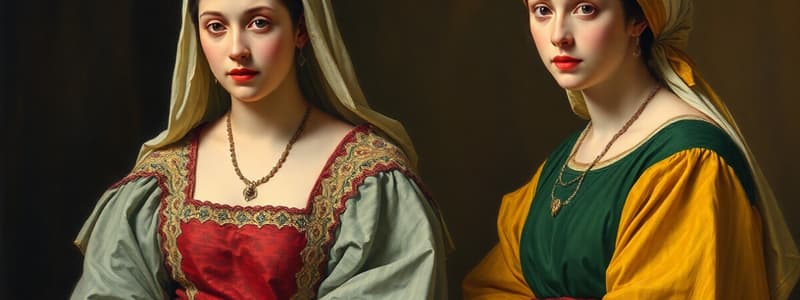Podcast
Questions and Answers
A kandura is a short garment typically worn in hot weather to keep cool.
A kandura is a short garment typically worn in hot weather to keep cool.
False (B)
The abaya is a fitted black cloak with no embellishments.
The abaya is a fitted black cloak with no embellishments.
False (B)
Cotton and linen are popular fabrics for traditional attire in hot climates, while silk is reserved for casual wear.
Cotton and linen are popular fabrics for traditional attire in hot climates, while silk is reserved for casual wear.
False (B)
Cultural attire specifically reflects Islamic values of modesty and is not used for personal identity.
Cultural attire specifically reflects Islamic values of modesty and is not used for personal identity.
Each emirate may have distinctive styles or colors for traditional attire, with the bold designs of Abu Dhabi being a prime example.
Each emirate may have distinctive styles or colors for traditional attire, with the bold designs of Abu Dhabi being a prime example.
Flashcards are hidden until you start studying
Study Notes
Men's Attire
-
Kandura (Dishdasha):
- A long, ankle-length garment, typically white or light-colored.
- Worn in hot weather to keep cool.
-
Ghutra:
- A headscarf, usually white or red-and-white checked.
- Secured in place with an agal (black cord).
-
Agal:
- A black cord worn to hold the ghutra in place.
-
Footwear:
- Leather sandals known as "na'al" are commonly worn.
Women's Attire
-
Abaya:
- A loose-fitting black cloak worn over regular clothes.
- Often embellished with embroidery or beadwork.
-
Shayla:
- A long scarf draped over the shoulders or wrapped around the head.
-
Burqa:
- A traditional face veil, some women choose to wear for added modesty.
-
Kaftan:
- A long dress that may be brightly colored and adorned with decorations.
Cultural Significance
-
Modesty:
- Clothing reflects Islamic values of modesty and decorum.
-
Identity:
- Traditional attire signifies cultural identity and heritage.
-
Occasions:
- Specific garments are worn for weddings, festivals, and other cultural events.
Fabric and Materials
-
Common Fabrics:
- Cotton and linen are popular for hot climates, while silk is used for formal occasions.
-
Quality:
- High-quality materials are often preferred, with an emphasis on comfort and aesthetic appeal.
-
Embellishments:
- Use of embroidery, sequins, and crystals to enhance appearance, particularly in women’s garments.
Regional Variations
-
Emirate-Specific Styles:
- Each emirate may have distinctive styles or colors for traditional attire (e.g., the softer colors of Abu Dhabi vs. the bold designs of Dubai).
-
Local Influences:
- Variations influenced by tribal distinctions or historical trade connections with neighboring regions.
-
Fusions:
- Increased adoption of contemporary fashion elements, blending with traditional styles, especially among younger generations.
Men's Attire
- Kandura (Dishdasha): A long, ankle-length garment, typically white or light-colored, worn in hot weather to keep cool.
- Ghutra: A headscarf, usually white or red-and-white checked, secured in place with an agal (black cord).
- Agal: A black cord worn to hold the ghutra in place
- Footwear: Leather sandals known as "na'al" are commonly worn.
Women's Attire
- Abaya: A loose-fitting black cloak worn over regular clothes. Often embellished with embroidery or beadwork.
- Shayla: A long scarf draped over the shoulders or wrapped around the head.
- Burqa: A traditional face veil worn for modesty.
- Kaftan: A long dress that may be brightly colored and adorned with decorations.
Cultural Significance
- Traditional clothing reflects Islamic values of modesty and decorum.
- Traditional attire signifies cultural identity and heritage.
- Specific garments are worn for weddings, festivals, and other cultural events.
Fabric and Materials
- Common Fabrics: Cotton and linen are popular for hot climates, while silk is used for formal occasions.
- High-quality materials are often preferred, with an emphasis on comfort and aesthetic appeal.
- Embroidery, sequins, and crystals are used to enhance appearance, particularly in women’s garments.
Regional Variations
- Each emirate may have distinctive styles or colors for traditional attire (e.g., the softer colors of Abu Dhabi vs. the bold designs of Dubai).
- Variations are influenced by tribal distinctions or historical trade connections with neighboring regions.
- Increased adoption of contemporary fashion elements, blending with traditional styles, especially among younger generations.
Studying That Suits You
Use AI to generate personalized quizzes and flashcards to suit your learning preferences.




